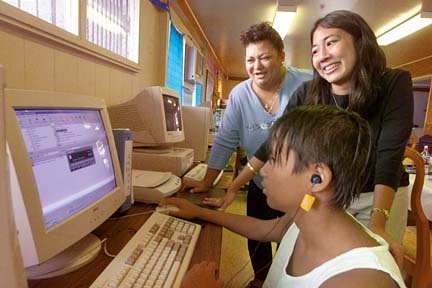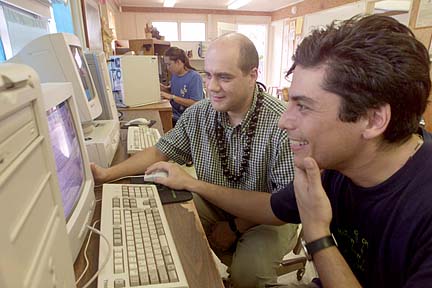


|
Opportunity Computer technician or auto mechanic?
knocks at Palolo
The Palolo Tech Center is
UH sponsors service-learning institute
a place for volunteerism, learning
and just hanging outBy Treena Shapiro
tshapiro@starbulletin.comSeveral days a week, Halau Lokahi eighth-grader Palani Carden finishes his homework, then heads over to the Palolo Public Housing Technology Center.
At 13, he is already thinking about the future, but has yet to decide what he will study in college.
Like the other Palolo Valley Homes residents who use the computer center, Carden spends a lot of time "burning" CDs to listen to at home. But he is also learning how to fix the computers, watching on Saturday afternoons as Kapiolani Community College associate professor Judi Kirkpatrick and University of Hawaii student Alan Dampoc maintain the center's computers.
On Friday, Carden brought in his family's broken computer to see if he could help them repair it.
"I'm trying to learn, know how to fix it," he said.
If he can learn to be a computer technician before he graduates from high school, that frees him up to study auto mechanics in college, he said.

|
Carden knew nothing about computers when he first showed up at the center, Dampoc said. But as he has tried his hand at some of the more technical stuff, "he's pretty good at it," Dampoc said."It's been pretty fun to watch it all," he said.
Dampoc, 31, is one of the UH and KCC students and faculty who volunteer at the center. Some of the students earn credits as part of a service learning program -- in essence, they learn by serving the community.
Kirkpatrick said another goal of the project is to get residents interested in higher education at KCC.
"They don't know they don't need a (diploma)," she said.
"If we can get them at KCC and get them registered, we can pay them to work back in the community."
Some of the residents have already learned enough to work there while they attend KCC, she said.
Atina Pascua, UH's service learning coordinator, said she hopes the program helps the students to become more civic-minded.
Dampoc, who has volunteered at the center for about a year, said he would eventually like to teach a course in computer science for the residents.
Student volunteer Leah Nakamura, 21, a pre-med student, said volunteering has gotten her to think about how she can help the people who come to the center. Some have medical insurance, but no transportation and will not catch the bus to see a doctor. Others just have no insurance.
"What can I do?" she asked. "How can I make a difference?"
The computer center is one of three in Hawaii, part of a nationwide $5 million program to get low-income minority communities access to the Internet and to teach residents how to use the Internet to improve their communities, said Carlos Ribeiro, a Brown University project associate. WorldCom, Brown University and Campus Compact provided the grant money to Hawaii and 19 other states.
Other sites in Hawaii are at Kuhio Park Terrace and Leeward Community College.
There are 15 computers at the Palolo center. The center is open for two hours each night during the work week and during the day Monday, Wednesday, Friday and Saturday.
Kirkpatrick is looking for more student volunteers and is working with the Palolo Tenants Association to try to train more tenants to keep the center open more hours.
Dahlia Asuega, the president of the tenants association, said very few of the residents in the low-income housing own working computers. Consequently, residents have been flocking to the center.
"It's being used every day, all hours," she said.
Sometimes she comes in to do paperwork after hours, and teenagers want to come in to make audio CDs and use the Internet for e-mail or to chat.
"It's a good place for the residents to just come in, hang out, play on the computers," Asuega said. "This has become the gathering place for the community.
"The kids pretty much come in and out as they please. It's a good place for them to just be, instead of out on the streets," she said.
Seventh-grader Patrick Carnate is learning how to make iMovies at school, then comes to the center after school to make his own CDs, downloading the music from the Internet and spending about $1 for the media. Sometimes he chats with others on the Internet.
"It's fun and it saves me some time on the weekend ... instead of just staying home."
Jeffrey Maene, 17, said he is in the center "whenever the thing is open" to burn CDs or watch videos.
"It keeps me out of trouble," he said.
Since his family has no computer, his parents often come by, too.
Sometimes his mother "gets over here first and no let me burn CDs," he said.